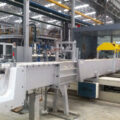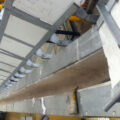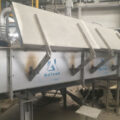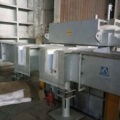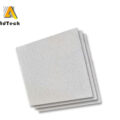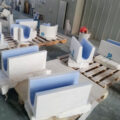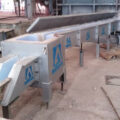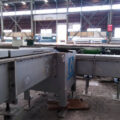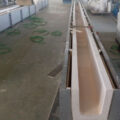The cover of the launder construction comprises a metal cover, such as a steel jacket; at least one electrical resistor, which is arranged so as to heat the lower part of the launder heating system; and an insulating layer to prevent the loss of heat by radiation through the metal shell. The heating resistor(s) is (are) located above the flow channel of the launder so that the heat from the resistors radiates essentially without obstruction on the metal, which flows on the bottom of the launder, and on the refractory lining. In the operating state, the electrical resistors are heated to 1100-1300° C.
The heat insulation is preferably made of ceramic wool insulation, whereby the insulation may comprise one or more layers of lining. The wool insulation in the cover and the ceramic launder preferably comprises aluminum silicate wool, magnesium silicate wool, or aluminum oxide wool, which endures high temperatures.
The heating resistors are thick enough, whereby any creeping and bending caused by the heat are minor. The heating resistor preferably consists of a metal rod or pipe with a round diameter. One or more heating resistors can be arranged in the cover to travel side by side in the longitudinal direction of the casting launder.

The resistors are preferably selected so as to have their operating voltage in the so-called safety voltage area. The resistors are preferably fitted in the cover part on so-called supporting cross-arms, which are arranged in the longitudinal direction of the refractory launder transversely under the resistors. The supporting cross-arms can be metal rods or pipes that are coated with ceramic refractory material.
The cover portion covers part of the launder heating system. The superimposed cover and launder constitute a launder channel. In a place, where the launder channel ends at the upper end, i.e., on the side of the incoming metal flow, an opening is formed, through which the gases are discharged as a result of the chimney effect from between the launder and the cover.
In the launder construction, a gas burner or a hot gas blower is arranged in this place, providing a stagnation pressure to limit or prevent the gas flow that discharges from the launder. The hot gas of the burner or the blower is directed towards the opening between the cover and the lower part, whereby the effect of the stagnation pressure becomes the strongest. The fuel of the burner can be, for example, natural gas or liquid gas. The hot gas burner maybe even electrically heated.
The power of the burner or the blower is controlled by means of a thermoelement installed at the lower end of the launder channel. The thermoelement indicates the temperature of the gas space at the lower end of the launder channel and the cooling effect of the cool air flowing into the launder channel. In the launder construction according to the invention, a power control for the heating resistors can be arranged to prevent the resistors from overheating. The thermal insulation material of the launder is used to limit its heat losses to such a level that the heating resistor’s own temperature will not exceed its normal operating range.


